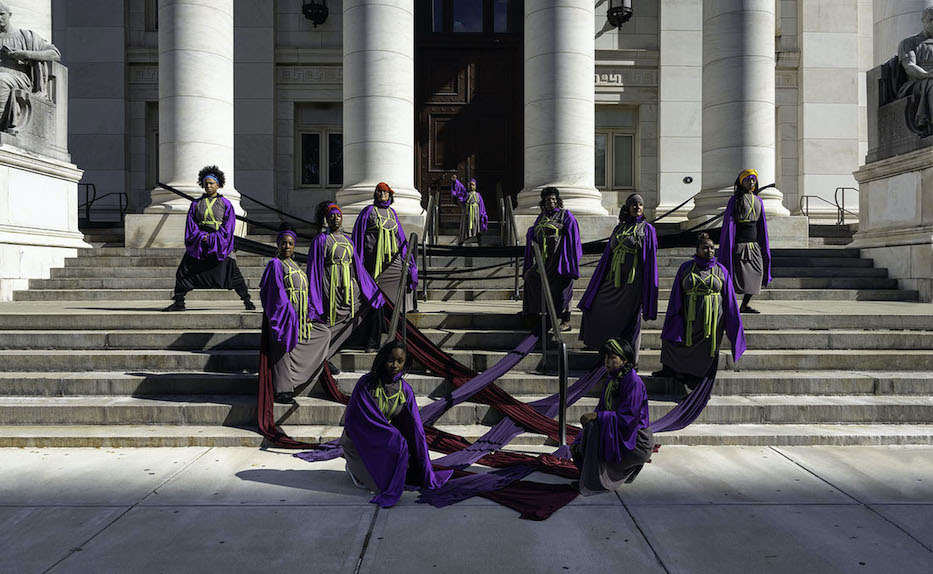
Downtown | Arts & Culture | Artspace New Haven | Ninth Square | COVID-19

| If Justice Is A Woman. Melanie Crean Photo. |
The girl is the heart of the photo, her right first raised to the sky. She stands in between two columns. As she lifts her arm, she glows in purple, red and yellow robes. Everything falls into place around her: the columns, the large, long door that glints in the sunlight, the women around and in front of her. Even in a pandemic, they manage a human chain, fabric weaving in and out between them.
Melanie Crean’s If Justice Is A Woman is the latest addition to Revolution On Trial: May Day and The People’s Art, New Haven’s Black Panthers @ 50, running at Artspace New Haven through Oct. 17. The work, which was installed and unveiled last Friday, marks the completion of months of planning and dialogue between Crean and several women who are activists, educators, and legal advocates in the city.
It feels right that the piece occupies an entire wall. Its subjects take up public space, and in so doing create an overdue reclamation.
The women pictured include Stetson Library Branch Manager Diane Brown and her 9-year-old granddaughter Jada, poet and anti-gun violence advocate Deborah Elmore, Artsucation Academy Network founder Hanan Hameen, dancer and Gateway Community College student Sharon Dickey, SWAN Director Beatrice Codianni, activists Barbara Fair, Kerry Ellington and Vanesa Suárez, and lawyer Hope Metcalf.
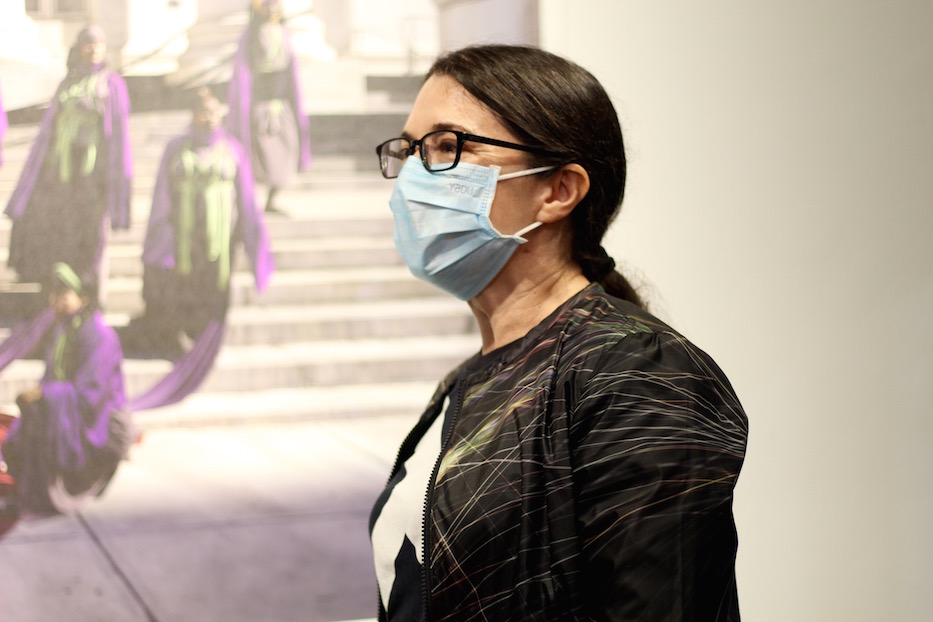
| The artist Melanie Crean at Friday's reception. Lucy Gellman Photos. |
“If justice was meant to be gendered as female, I wanted to ask people who don’t identify as men—people who identify as women or gender non-binary—what their idea of justice is,” Crean said at a small, masked and socially distanced reception Friday night. “And so we got a group of these women, and they came together.”
The project grew out of a prompt to “consider any changes or evolution in the U.S. justice system since 50 years ago,” Crean said. Five decades ago, May Day 1970 and the trials of Bobby Seale, Ericka Huggins and other members of the Black Panther Party for the murder of suspected FBI informant Alex Rackley rocked New Haven. On May Day, thousands of activists gathered on the New Haven Green, in a crowd that was only recently matched by a 2016 visit from Bernie Sanders. Members of the National Guard also converged on the city; Brown remembers seeing snipers on the roofs of downtown buildings.
On the gallery’s end, Crean and then-Director Helen Kauder reached out to Brown, who has been a fixture in the Dixwell and Newhallville communities for decades. A kid when the Panther trials took place, Brown began reaching out to a few women in the community, from now-elders who had been on the Green during the trials to younger activists who were in their 20s and early 30s. Those women were able to nominate other women, in what became the group represented in the photograph.
Crean, meanwhile, was taken by two lunettes at the New Haven County Courthouse, both painted by Thomas Gilbert White in 1913. Both sit above courtrooms and show the idea of justice in biblical, mythical proportions: Moses delivers it generously to a crowd below, as a pair of shackles come clear off a white man. Nearby, a woman dressed in gauzy white raises her arm, nymph-like as she embodies justice. For Crean, the idea seemed strange and archaic.
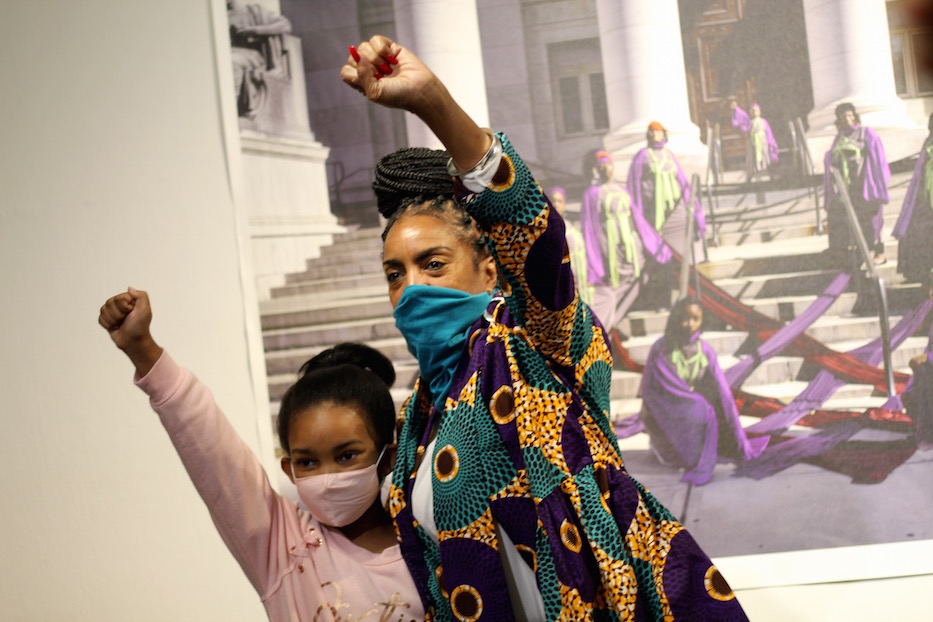
“So much has actually remained the same,” she said. “The idea of this system that supposedly existed, and supposedly existed only by and for a very small group of people that was completely not representative of who actually lives in this country is still the white supremacist idea that exists now.”
Before COVID-19, the group met every few weeks at Artspace and then at Stetson, which Crean described as “like meeting at a family member’s house.” Over lunch, members told stories from their own lives, tying each back to their own personal concept of justice. They came up with four overarching themes: power, struggle, resistance, and hope and healing. The last time they saw each other was at the beginning of March; Crean set a date for the artwork in April.
Then the pandemic hit, forcing the library to close its five branches as Artspace pushed the exhibition back. Crean pivoted to a series of phone interviews, which became the foundation of a temporary narrative piece on display when the show opened in late June. She continued to design outfits for the portraits, with a purple meant to reflect royalty. The group was finally able to gather in person on Sept. 19 and 20, just as Americans were reeling from the news of Justice Ruth Bader Ginsburg’s passing.
Due to social distancing regulations, Crean linked the women with lengths of yellow and red fabric and velcro, so that they are touching without touching. It is a nod to the fact that all of the women made a similar suggestion: justice must be horizontal and widely diffused, rather than hierarchical, rarefied and concentrated. All of them mentioned mutual aid work, which has taken on greater urgency during the pandemic.
Each of the women photographed have a different relationship to the Black Panther trials—and to intergenerational activism and mutual aid work in New Haven. Now 62, Brown was nine or ten when she first learned about the Panthers’ vision, from education that centered Black power and liberation to its free breakfast program.
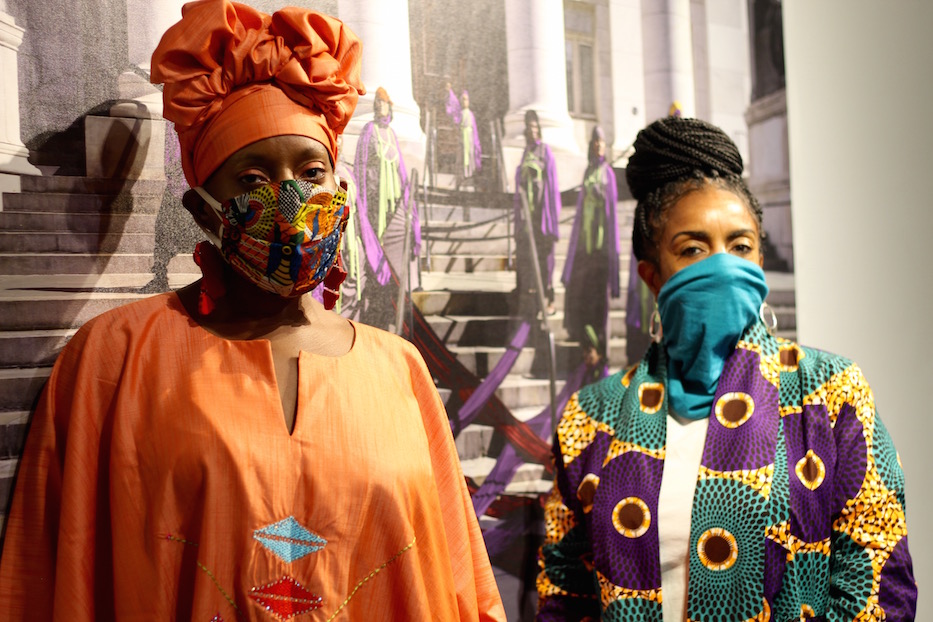
From her mother Lilian Brown—one of Newhallville’s first Black homeowners, and a woman who was later beloved as the neighborhood’s godmother—Brown had a distinct sense of pride in her Blackness and her history. She didn’t see the same among many of her Black peers—until the Panthers began their reeducation campaign. Suddenly, they were learning the same gospel of Black liberation that she had been taught at home.
"They instilled a certain sense of pride and they taught us things about our history and our culture," she said. "They left memories, good memories, and they instilled in people like myself some very good things. Pride, don't give up the fight, stay in the struggle. I'm 62 and I'm still in the struggle. Part of their legacy is left in me. And there are so many of me around this world."
When she was 13, the trials rocked the city. Seeing her daughter’s interest, Lilian Brown gave Brown and a group of peers permission to march down to the Green from Bassett Street, accompanied by a group of volunteer camp counselors from Yale University. The group—Black kids and a mix of Black and white counselors—marched from Bassett to Shelton Avenue, and Shelton to Dixwell. When they arrived at the Green, she saw hundreds of people who were there for the same reason.
She went back multiple days in a row. On the second or third day of the trials—she can’t remember which—she managed to squeeze inside the New Haven County Courthouse, shoulder-to-shoulder with people who were trying to cram in. While “we didn’t get that far,” some of the Yale students did. They later explained to her that many of the Panthers knew the law, and were quoting it to the letter as they defended themselves and their colleagues.
“It was just amazing to me,” she said. “That was somewhat of a turning point. I had been around the Panthers. I had spoken to them. They had been to my house. I’d gone to political education classes where we studied Mao Zedong and the Little Red Book. I remember all that. But for someone to tell me that they were actually in the courtroom defending themselves—I heard the story myself. They were painting them as terrorists and radicals, but in fact they were all very well educated individuals. I was very impressed and I was very proud.”
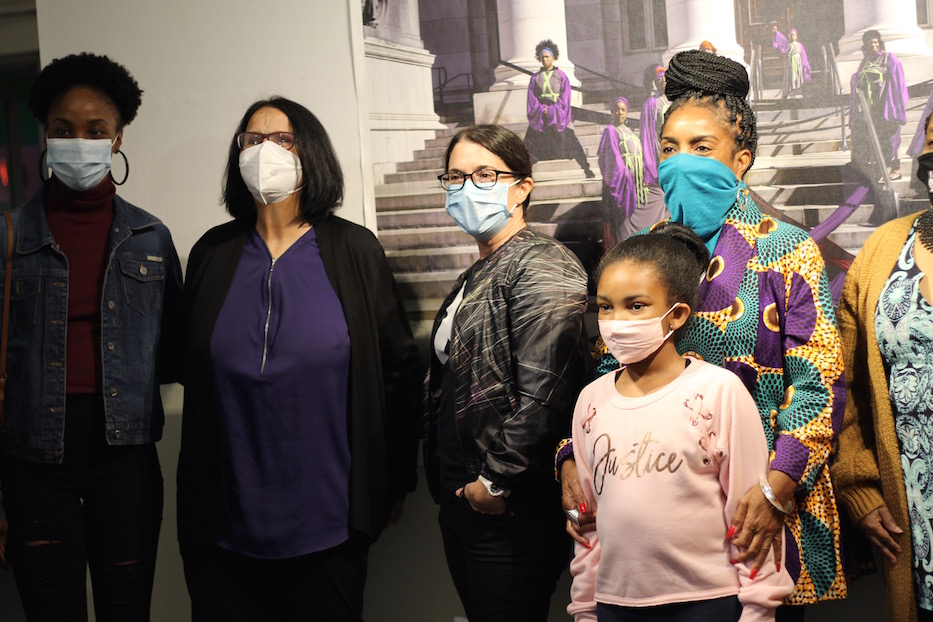
When revisiting the history decades later with Crean, she knew that she wanted to bring in her granddaughter, who is around the same age that she was when she first learned about the Panthers. This year, Brown has taken Jada to watch Black Lives Matter rallies and protests at a distance. The two have made time to view the new murals by members of Black Lives Matter New Haven and celebrate the new sculpture of William Lanson on the Farmington Canal.
She sees history repeating itself, she said. As she spoke, a video from protests around the officer-involved shooting of Stephanie Washington and Paul Witherspoon ran on loop in the next gallery. The protests, led by a group of queer Black women, lasted for over five days and brought the New Haven, Hamden, and Yale communities together in a collective call for police accountability. Jada, who attended Friday’s event, said she is glad to be part of that history.
“I feel supported in being a part of the group,” she said, looking up at the portrait with wide, soft eyes. Multiple times throughout the evening, she stood beside or in front of the image, raising her fist just as she had on the steps of the courthouse.
Codianni, who was nominated by longtime activist Barbara Fair, was 22 when the Panther trials started. Friday, she remembered gathering on the New Haven Green to protest what she saw as a grave miscarriage of justice. Fifty years later, she has continued to fight for social, racial and economic justice through her work with SWAN, the Sex Workers and Allies Network.
“So many people from the community came together,” she said. “It was this great, powerful, educational time. We thought we were gonna change the world. And we did, incrementally. It was very beautiful. Younger people today have the same feeling, and the same goals. And I hope they are more successful than we were.”
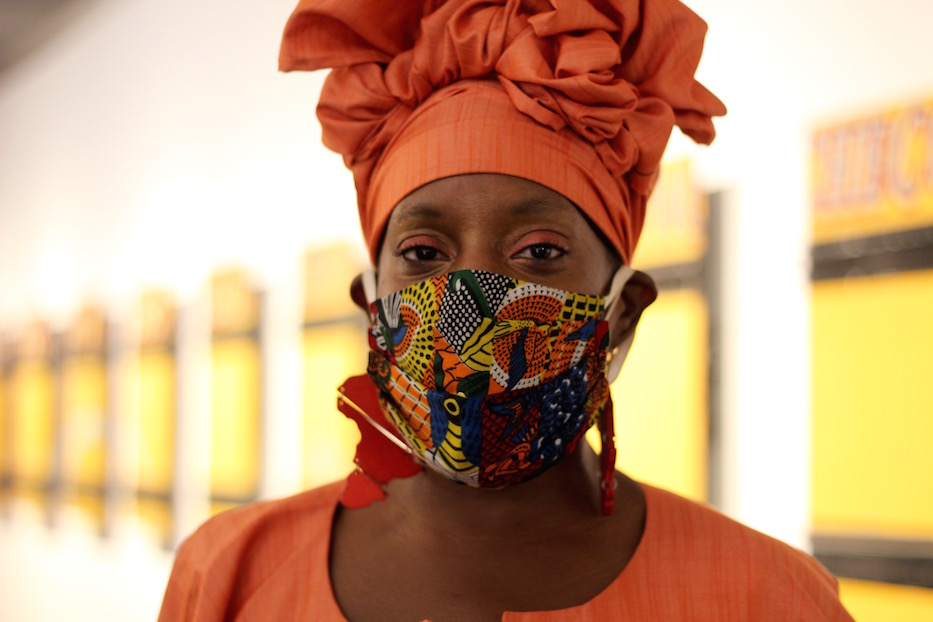
Codianni met Fair decades ago, when they were both protesting Connecticut’s move to send hundreds of incarcerated people to Virginia, in a system of prison export in which multiple states participate. The two have remained “friends, comrades, sisters” since. She has also done work with Metcalf, whose legal advocacy focuses on stopping solitary confinement in Connecticut.
“These are true activist-organizers, warriors for justice, and I’m so proud to be included,” she continued, motioning to the portrait. “It does a heart good to see this. In Kerry [Ellington], Vanesa [Suárez], I see a fiercer version of myself. These women are warriors.”
41-year-old Hameen, whose dad is the drummer Jesse Hameen II, was raised hearing about the Panthers from her family and their larger Nation Of Islam community. As a kid, her dad grew up alongside Brown’s brothers; she now refers to Brown as her auntie. Her cousin is the former Panther George Edwards, who is still doing mutual aid work in New Haven at 83 years old.
While she was not alive for the trials, “I grew up in a household that was proud of being Black,” she said. She carried that with her through school, during which she was often one of the only Black students in gifted and talented programs, and faced racial epithets from both her peers and her teachers.
Then she carried that with her through the founding of the Artsucation Academy Network and instruction as a dance and movement educator. She is now dedicating her life to Black liberation through education, including her monthly “Africa Is Me” classes at Stetson Library and cultural exchange work in Senegal.
“This is showing that you can be strong and proud of whoever you are,” she said. “That there’s nothing wrong with that—that everything is right with that.”
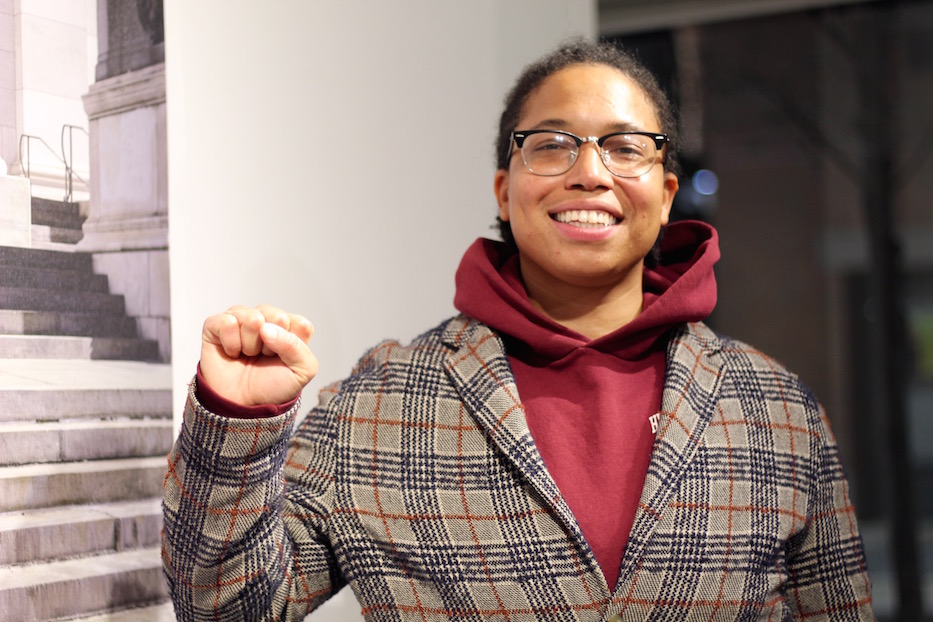
Kerry Ellington: "It's a journey."
Some of the activists pictured are in their 20s and 30s, and still very much fighting on the front lines. Friday, Suárez was unable to make the reception because she was in East Haven, calling for justice for Lizzbeth Alemán-Popoca 85 days after her body was found in a shallow grave behind LoMonaco’s Ristorante in Branford.
An arrest has not yet been made in Alemán-Popoca’s case. For Suárez, the activism is part of her daily life: she spends time helping women escape situations of domestic abuse and violence, does mutual aid work, and has led protests for Indigenous rights in the city.
Kerry Ellington, who started her evening with Suárez in East Haven, said that appearing in the portrait was a deeply emotional experience for her. When she walks into the gallery, she sees herself in three places: Crean’s photograph, Kwadwo Adae’s portrait of her in her “protest armor,” and film footage from last year’s protests for Stephanie Washington and Paul Witherspoon.
“It’s a journey—there’s a lot of grief and struggle being told here,” she said. “When we were calling for justice for Stephanie and Paul, I remember not knowing what to do and being completely enraged. We got a lot of change in the first five days. As much as there was grief and pain, there was also a lot of Black joy out there.”
In the photograph, she looks out at the viewer with unblinking eyes, fabric pulling at sections of her hair that fan out, declarative. Her legs plant themselves firmly in the ground; she’s fully present. She explained that her understanding of the Panthers has been integral to the way she shows up and calls for social justice. Now 34, Ellington first heard of the Panthers when she was just a kid, and found a documentary on their work online.
“I was very moved by it,” she recalled. “The Panther spirit is very much alive in this city. It should be honored every year. We get to learn from them and be unapologetic about our rage and about justice. I wouldn’t be doing this organizing if I didn’t get to learn about the Panthers.”
Since those formative years, she has continued to fight fiercely with People Against Police Brutality, including as recently as earlier this month. During the second week of October, she led an action in Norwalk on behalf of 19-year-old Vincent “Kuda” Fowlkes, who was killed in 2017 during a high-speed police chase from Officer Ramon Tejada. Fowlkes’ 22-year-old stepbrother Shawn Bowman sustained significant brain damage in the same crash.
On Oct. 6, the Connecticut Superior Court dismissed a lawsuit filed against Tejada alleging that he caused the crash. Ellington led the action the following day, just days before joining Suárez in East Haven. She has also been at the forefront of Justice for Jayson and actions across the state.
Because of that work, the show is bittersweet: it shows how much activists have done, and how much there is still left to do. She acknowledged that activists on the front lines are usually the last ones to practice the same self-care they may exhort.
“It’s hard to heal,” she said. “It’s hard to rest and to recover when your wounds keep being stomped on.”

